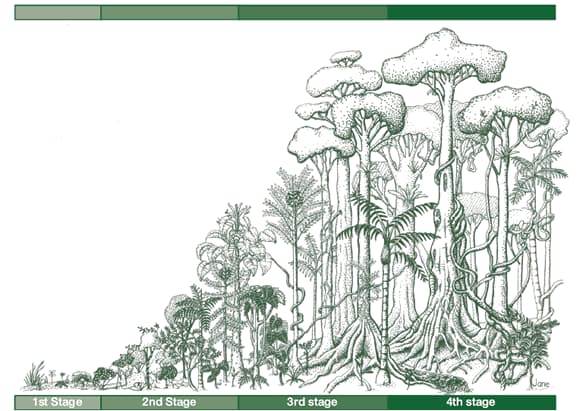Rainforest Regeneration
Natural regeneration - the forest floor has a memory
Look up as you walk through the Reserve and you will see the openings created by tree falls. You might think little has changed in the rainforest for thousands of years but the younger generation of plants have been waiting for this opportunity.
Deprived of light, most rainforest plants mark time as seeds or seedlings until a gap appears in the canopy when they suddenly emerge from dormancy. The result is a race for light by both slower growing species and the fast growing pioneers. Only a lucky few will make it to the top to help form the natural closed canopy.
Regeneration of an area seems to occur in four stages.

- 1st Stage Year 1: Pioneer seedlings and herbaceous plants colonise the open soil.
- 2nd Stage 10-50 Years: Pioneers colonise and spread their seeds, eg bleeding heart, native peach, and pencil cedar.
- 3rd Stage 50-200 Years: Secondary species, which are still dependent on pioneers, become established, eg bumpy ash, black bean and native tamarind
- 4th Stage Mature Rainforest 500 Years +: Longer lived species, eg strangler figs, laurels, pigeonberry ash, are reliant on a nearby seed source for regeneration to climax forest.
Gaps are formed in the forest canopy when a tree or branch falls. The hole in the canopy provides the opportunity for the forest to move through the stages of rainforest regeneration described above and is soon closed over. Fallen trees and branches are taken care of by nature’s recyclers: fungi, animals and insects are soon fast at work decomposing a fallen log. This breakdown of organic material into its component parts which are then taken up by the plants as nutrients, is called the litter cycle. It proceeds with speed and efficiency in the warm, moist conditions of the rainforest. Plants, animals and climatic forces are continuously interacting causing subtle and sometimes dramatic changes. (Illustration by Jane Thompson)
Precious Plants – Amazing Animals – Brilliant Birds – Bush Tucker Guide